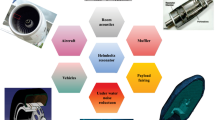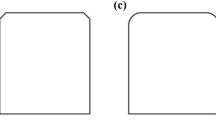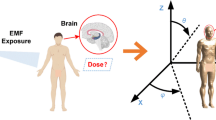Abstract
In this paper, finite element method is used to study the strong electromagnetic pulse into the computer box with holes to calculate the influence of shielding the computer box. Then strong electromagnetic pulse coupled into the shielding box with holes is studied in the same way. The relationship between the simulation resonance frequency and the theoretical results are calculated by research different the computer boxes’ shielding effect under different electromagnetic pulse’ frequency; the influence of the holes’ shape and size on shielding effect is also simulated. It is concluded that the computer box’s shielding effect is poor under the resonance frequency, and there are no linear relationship between shielding effect and hole’s size. The shielding effect becomes worse because of resonance coupling with the size of the hole unchanged the holes’ size.





















Similar content being viewed by others

References
Ting, A., Shang-he, L.: Study on the UWB electromagnetic pulse effects of a kind of equipment. High Volt. Eng. 34(11), 2428–2432 (2008)
Thottappillil, R.: Electromagnetic pulse environment of cloud-to-ground lightning for EMC studies. IEEE Trans. Electromagn. Compat. 44(1), 203–213 (2002)
Zhi-Hong, L., Kiang, J.-F.: Long-range pulse propagation over different surfaces using domain-decomposition FDTD method. In: iWEM2011—IEEE International Workshop on Electromagnetics, pp. 214–216
Mottahed, B.D., Manoochehri, S.: Effects of angle of cut and gap size on the electromagnetic shielding effectiveness. In: International Symposium on Electromagnetic Compatibility, pp. 128–131 (1994)
Saito, T.: Shielding performance of open-type magnetic shielding the computer box structure. IEEE Trans. Magn. 4640–4643 (2009)
Li, X., Ji-hui, Y., Yong-ming, L., Quan-di, W.: Simulation of electromagnetic interference to circuits inside shielding the computer box by wire penetrated with aperture. J. Syst. Simul. 3891–3, 3954 (2007)
Tominaga, T., Shirai, T., Kosukegawa, M.: Study on simple magnetic shield for AC magnetic standard. Jpn. Electr. Meters Insp. Corp. 1–7 (1998)
Mottahed, B.D., Manoochehri, S.: Joint design methodology based on the electromagnetic shielding effectiveness capabilities. IEEE Trans. Compon. Packag. Manuf. Technol. 19(1), 238–247 (1996)
Nagano, I., Yoshimura, Y., Yagitani, S., Yokomoto, H., Tosaka, T., Nakayabu, T.: Estimation of the electric parameters of thin electromagnetic shielding materials. Electr. Eng. Jpn. 147(1), 1–9 (2004)
Chao, Z., Hang, S.: Numerical calculation on coupling effects of metallic cavity with slot by using FDTD. J. Inf. Eng. Univ. 9(4), 408–411 (2008)
Acknowledgements
The study was supported by “Shanghai Aerospace Science and Technology Innovation Funds, China (Fund No. SAST2015103)”. And supported by “National Natural Science Funds Project (Fund No. 11502118)”
Author information
Authors and Affiliations
Corresponding author
Rights and permissions
About this article
Cite this article
Cao, B., Pan, X., Liu, C. et al. Simulation research on shielding effect of computerized boxes with electromagnetic pulse hole based on finite element analysis. Cluster Comput 22 (Suppl 6), 15149–15158 (2019). https://doi.org/10.1007/s10586-018-2518-z
Received:
Revised:
Accepted:
Published:
Issue Date:
DOI: https://doi.org/10.1007/s10586-018-2518-z



